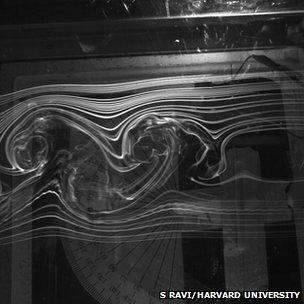Bumblebee flight inspires 'bad weather robot' design
- Published
The footage revealed how in unsteady airflow, the bumblebees roll to correct their flight path
Scientists are studying the flight of the bumblebee in an effort to work out how the insects manage to remain steady in adverse weather conditions.
Dr Sridhar Ravi, from Harvard University, filmed bumblebees as they flew in a wind tunnel.
This enabled Dr Ravi and his team to control the airflow the bees had to contend with.
The researchers say their study could aid the design of "micro air vehicles" that remain stable in bad weather.
They explained in a paper in the Journal of Experimental Biology, external that they had studied bumblebees because they were "all-weather foragers".
Dr Ravi told BBC News: "As we have all experienced, the wind speed and direction outdoors can be very variable, [so] maintaining stable flight can be extremely challenging.
"The best micro air vehicles [with a wingspan of less than 25cm (10in)] available today struggle to fly stably when there is even in a light breeze.

Smoke trails in the wind tunnel reveal the vortices and "unsteady airflow"
"Yet, insects seem to be capable of flying even in extreme wind conditions."
Using a wind tunnel allowed the researchers to recreate these conditions.
They filmed the bees using high-speed cameras in order to replay their flight in very slow motion and discover how the insects adjusted their flight according to the airflow.
This footage revealed that the bees reduced their speed in unsteady winds, which seemed to allow them to expend more energy correcting their flight path.
"The bumblebees also seemed to be more susceptible to disturbances that pushed them sideways as opposed to up and down," explained Dr Ravi.
"The bees rolled considerably to change course and correct for the disturbances induced by the wind."
The scientist said that a better understanding of how natural flyers contended with turbulent wind would help "immensely" in the design of micro air vehicles that flew in adverse weather.
He added: "We are currently conducting more experiments including flying other insects in similar wind conditions and identifying the influence of pollen and/or honey on the flight stability in the bees."
- Published17 September 2013
- Published18 July 2013
- Published22 September 2010
- Published2 May 2013